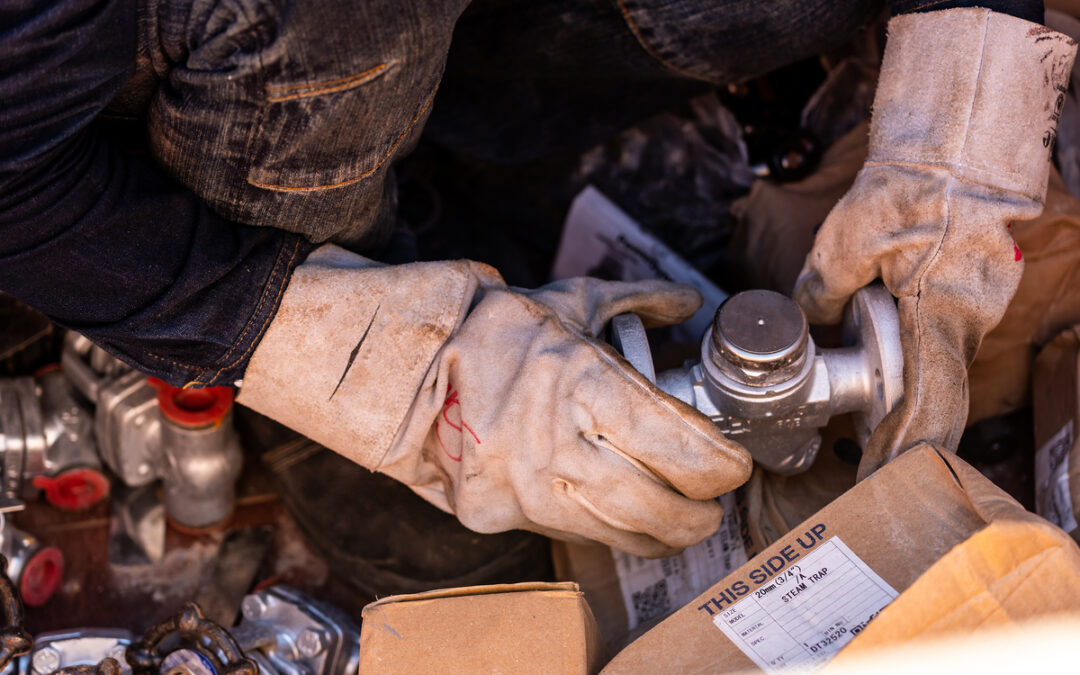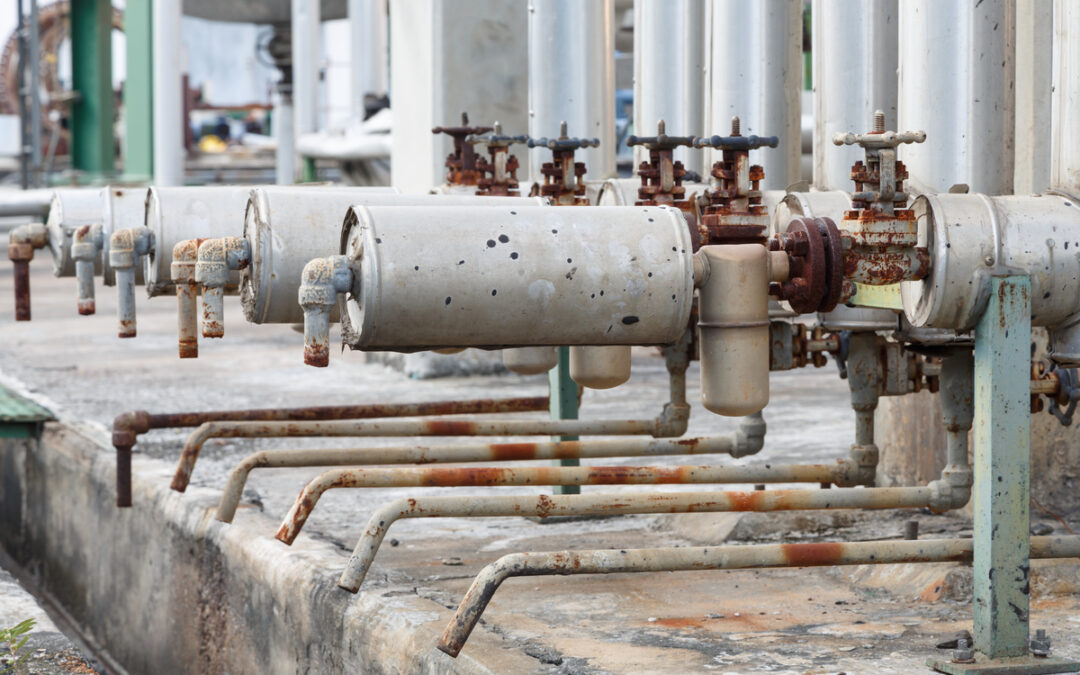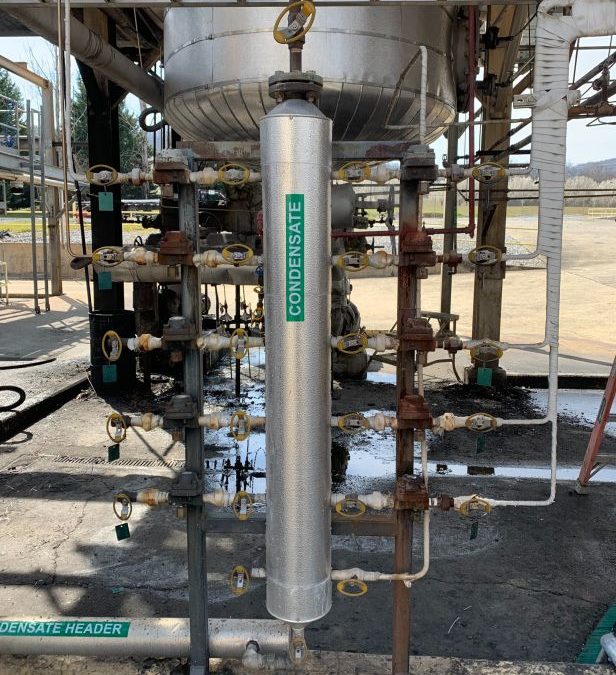
by PALA Group | Oct 22, 2024 | Steam Traps
A steam trap is a device used in an industrial steam system to remove condensate, air, and other non-condensable gases from the system while preventing the loss of live steam that’s used for heating, power generation, and sterilization.
Learn more about what a steam trap is and how it works >>
When steam traps malfunction, the efficiency and safety of the entire steam system can be compromised, leading to costly issues and significant energy loss. This article explores why steam traps fail, how failures affect the larger steam system, and what you can do to address and prevent these issues.
5 Reasons Steam Traps Fail
Anything mechanical can malfunction; steam traps are no exception. Below are the top five reasons steam traps fail, how those failures affect the larger steam system, and steps you can take to address and prevent these issues.
1. Worn-out or Damaged Components
According to industry studies, roughly 10-15% of steam traps in a typical industrial facility may fail each year due to worn components. In high-temperature, high-pressure environments, steam trap valves, seats, and mechanisms can degrade over time. This degradation can cause traps to either fail open or fail closed.
- Failing open allows steam to escape, leading to energy inefficiency, increased fuel costs, and potentially damaging downstream equipment.
- Failing closed prevents the proper discharge of condensate, resulting in water hammer (hydraulic shock), corrosion, and impaired heat transfer in the system.
2. Blocked or Clogged Traps
Another common cause of steam trap failure is blockages from dirt, scale, and debris in the system. When condensate and impurities are not removed efficiently, the trap may become obstructed, preventing it from functioning as designed.
Clogging can cause back pressure, reducing the flow of steam and affecting the efficiency of the entire steam system. And, in severe cases, blockages can lead to water hammer, which occurs when slugs of condensate move at high speed through pipes, potentially causing extensive damage to valves, piping, and other equipment.
3. Incorrect Sizing or Installation
Steam traps must be properly sized and installed for the specific operating conditions of the steam system. Incorrect sizing can lead to inefficient operation and premature failure. For example, an oversized steam trap might cycle too quickly, causing wear and tear, while an undersized trap may not be able to handle the volume of condensate, leading to flooding or water hammer.
Improper installation can also affect the trap’s functionality. If a trap is installed without proper drainage or if it’s not level, it may not operate as intended, leading to issues such as condensate buildup or steam leaks.
4. Failure Due to Pressure and Temperature Fluctuations
Industrial steam systems experience fluctuations in pressure and temperature, which can place extra stress on steam traps. Abrupt changes in these conditions can cause traps to fail. For instance, rapid pressure changes may cause mechanical parts to seize or malfunction.
Thermostatic traps are particularly susceptible to temperature fluctuations because they rely on temperature differences between steam and condensate to function properly. Frequent cycling or thermal shock can cause premature wear, reducing their lifespan.
5. Lack of Regular Maintenance
Like all mechanical equipment, steam traps require regular inspection and maintenance to ensure proper operation. Unfortunately, many facilities neglect regular steam trap audits, leading to undetected failures that affect the entire steam system’s efficiency. Facilities that regularly inspect and maintain their steam traps can reduce energy loss by as much as 20%.
How Steam Trap Failure Affects the Entire Steam System
The failure of even a single steam trap can cause a chain reaction of costly issues throughout the entire steam system.
When steam is lost through a failed-open trap, the system has to work harder to maintain pressure and temperature, leading to increased fuel consumption and higher operational costs. According to the U.S. Department of Energy, a single failed steam trap can waste approximately $6,600 annually in lost steam. This also results in reduced efficiency in processes relying on steam, such as heating or sterilization.
When traps fail closed, condensate builds up in the system, causing water hammer, corrosion, and uneven heat distribution. Over time, this can lead to costly equipment damage, safety hazards, and unplanned downtime.
What to Do About Steam Trap Failure: Create a Proactive Action Plan
Preventing steam trap failure requires a combination of regular maintenance, expert oversight, and the use of the right technology. Here’s a proactive action plan to ensure your steam traps stay in optimal working condition.
Implement a Steam Trap Station Management Plan
A well-designed steam trap station management program helps ensure that steam traps are regularly inspected, maintained, and replaced as needed. This program should include:
- Routine visual and ultrasonic inspections to detect leaks, blockages, or malfunctioning traps.
- Documenting trap performance and scheduling replacement or repairs for aging traps.
Use Expert Contractors for Installation and Maintenance
The expertise of trained professionals is essential for ensuring that steam traps are properly installed and maintained. Working with expert contractors who specialize in industrial steam systems can help prevent common installation errors and ensure that the right type of trap is used for each application.
Embrace Technologies for Better Monitoring
Modern technologies, such as remote monitoring systems and wireless steam trap sensors, allow for real-time monitoring of steam traps. These tools provide data on trap performance, alert operators to potential failures, and reduce the need for manual inspections. This can lead to significant energy savings and prevent downtime.
Perform Regular Steam System Audits
In addition to inspecting individual steam traps, conducting regular audits of the entire steam system is essential. These audits should assess the system’s pressure, temperature, and flow rates to identify any issues that could affect trap performance.
Replace Aging or Inefficient Traps
Don’t wait for a failure to occur. Replace steam traps that are nearing the end of their lifecycle or those that have become inefficient. Investing in high-quality, properly sized traps will help maintain system efficiency and prevent costly failures.
Contact PALA to Ensure a Problem-free Steam System
As a licensed industrial and mechanical contractor with the credentials to work in the most demanding facilities, our team can perform a wide variety of services to repair and maintain your entire steam system. From component replacement to completely reworking your system’s piping and fittings, we can get your system back up to optimal performance. Give us a call or contact us online to get the process started.

by PALA Group | Apr 16, 2024 | Steam Traps
Ever wondered what keeps your steam system running smoothly and efficiently? The answer lies in a small, but mightily important component: the steam trap. These integral devices are the unsung heroes of steam systems, ensuring that steam flows where it’s needed while preventing energy waste and condensate backup. In this article, we’ll dive into the critical role of steam traps and offer a primer on the different types available – from mechanical and thermostatic to thermodynamic variants.
First, if you’d like to enhance your understanding and optimize your steam system, explore more details on steam traps and this guide to steam system optimization.
Checklist for Routine Steam Trap Maintenance
Maintaining steam traps is crucial for ensuring efficient operation and preventing costly energy losses. Regular maintenance not only extends the lifespan of steam traps but also enhances system performance. Here’s a comprehensive checklist outlining essential tasks for routine steam trap maintenance.
1. Cleaning
- Inspect steam traps for any visible signs of dirt, debris, or corrosion.
- Use appropriate cleaning tools to remove any buildup or blockages within the steam trap.
- Ensure cleanliness of surrounding areas to prevent contamination of the trap.
2. Steam Trap Inspection
Steam traps play a pivotal role in the efficiency of steam systems. Proper inspection methods are essential to identify potential issues and ensure optimal performance. Here are various methods for testing and inspecting steam traps:
Visual Inspection
- Regularly inspect steam traps for any signs of leakage, such as steam escaping or water pooling around the trap.
- Look for physical damage, such as corrosion or rust, which can indicate potential issues with the trap’s integrity.
- Check for proper installation and ensure all connections are secure.
Ultrasonic Testing
- Utilize ultrasonic testing equipment to detect internal leakage or blockages within the steam trap.
- Conduct periodic ultrasonic inspections to identify anomalies in the trap’s operation, such as excessive noise or irregular flow patterns.
Temperature Monitoring
- Use temperature monitoring devices to assess the temperature differential across the steam trap.
- Anomalies in temperature readings can indicate potential problems, such as blockages or failed components within the trap.
3. Adjusting Steam Traps
- Periodically adjust steam traps to ensure they are operating at optimal performance levels.
- Monitor steam trap discharge to maintain proper condensate removal without unnecessary steam loss.
- Adjust trap settings based on system load and operating conditions to maximize efficiency.
Importance of Scheduling Routine Maintenance
Scheduling routine maintenance for steam traps is paramount to prevent issues and optimize system performance. Regular maintenance helps in:
- Identifying and addressing potential problems before they escalate, reducing the risk of costly repairs or downtime.
- Improving energy efficiency by ensuring steam traps operate at peak performance, minimizing energy wastage.
- Extending the lifespan of steam trap components, reducing the need for frequent replacements and associated costs.
By following a comprehensive maintenance checklist and conducting regular inspections, you can ensure the reliable and efficient operation of its steam system, ultimately contributing to cost savings and operational excellence.
Deciding Between Steam Trap Repair and Replacement
Knowing whether to repair or replace a steam trap is crucial for maintaining your steam system’s efficiency and reliability. There are several signs and factors that can help you make an informed decision.
- Visible wear or damage: Any signs of physical damage or corrosion could affect the trap’s functionality.
- Unusual noise: Strange noises may indicate internal problems or that the trap is not functioning correctly.
- Inconsistent performance: Fluctuations in steam quality or temperature can be symptomatic of a faulty trap.
- Increased energy consumption: If your energy bills are rising without a corresponding increase in steam demand, your steam trap could be to blame.
Once you’ve identified an issue, the next step is to decide if repair or replacement is the most cost-effective and practical solution:
- Assess repairability: Consider if the steam trap’s issues can be easily fixed with a repair kit or if the damage is too extensive.
- Analyze lifespan and performance: Sometimes, even if a repair is possible, replacing an aging trap with a more efficient model can save money in the long run.
- Consider operational downtime: Evaluate how long your system can afford to be inactive and whether that aligns better with repair or replacement.
We cannot overstate the importance of timely action. Ignoring problems or delaying decisions can result in system failures, safety risks, and increased operational costs. Whether it’s a repair or a full replacement, addressing issues with a malfunctioning steam trap should never be postponed.
When to Call a Steam Trap Expert
Steam trap issues can range from simple to complex, but knowing when to call a professional can save time and protect your system from further damage. While some problems might be within the capabilities of your maintenance team, others will demand the expertise of a steam trap technician or engineer. It’s crucial to recognize the signs that indicate a need for professional intervention.
- Recurring Problems: If a steam trap continues to fail after multiple attempts to repair or replace it, this may suggest an underlying issue with your system that requires expert analysis.
- Multi-point Failures: When numerous steam traps within your system are failing, it’s time to call an expert. This pattern may point to a systemic problem rather than isolated incidents.
- High Energy Costs: An expert should be consulted if you notice a sudden spike in energy costs that could be tied to steam trap inefficiencies or failures.
- Unusual Noise or Vibration: Excessive noise or vibration coming from steam traps or the connected piping system could be a sign of problems that are best diagnosed by professionals with specialized equipment.
- Unique System Requirements: Certain systems have specific needs that may not be obvious to general maintenance personnel. Experts can identify and address these requirements.
- Large-Scale Upgrades: If you are planning a major upgrade to your steam system, it’s advised to work with a steam trap engineer to ensure that all components are suitable and optimized for your setup.
Dealing with steam traps can be complex, and in some cases, misunderstanding the issue can lead to unnecessary downtime and expenses. A trained expert has the experience to quickly diagnose complex situations and determine the most efficient and cost-effective solutions, ensuring your systems operate at peak performance.
Consistent attention to steam trap maintenance isn’t just a technical requirement—it’s a critical part of operational success. We’ve emphasized the importance steam traps play in steam systems and how effectively managing them is essential for system efficiency. From understanding their purpose to meticulous maintenance and troubleshooting, we’ve covered the key aspects necessary for optimal steam trap performance.
We urge you to view your steam trap system not just as a set of components, but as the lifeblood of your operations. Its condition directly impacts the health and performance of your plant. Each properly functioning steam trap reduces energy waste and enhances operational excellence. Embrace these best practices, enhance your system’s reliability, and witness the benefits in the form of an efficient, sustainable, and economically viable steam system.



